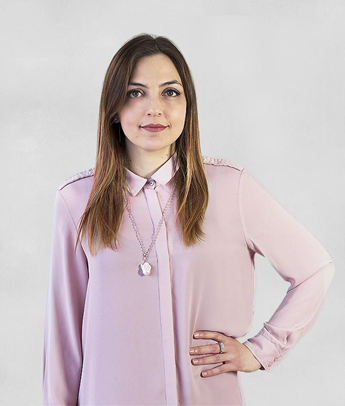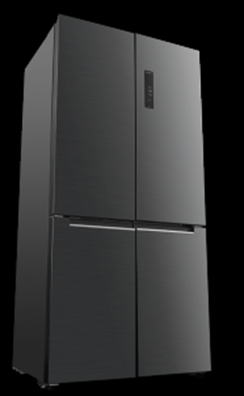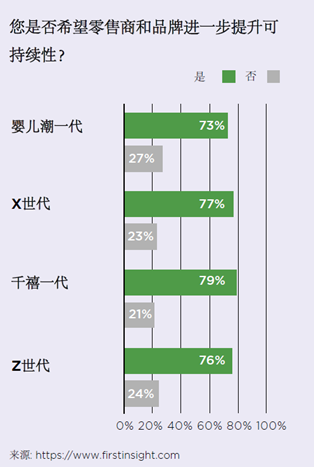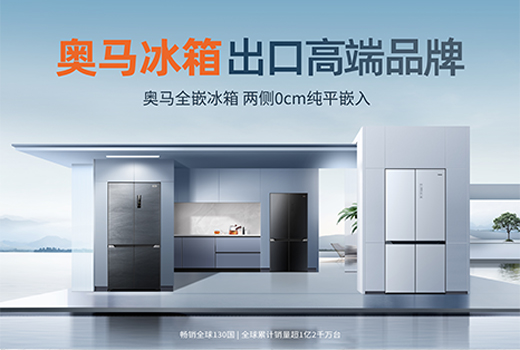
Studio Volpi技术总监Silvia Torretta
What is your definition of quality in refrigerators?
您如何定义冰箱品质?
Let’s start with a few words on the basic and expected quality in today’s refrigerators. I would say that the first quality parameter of any home appliance is durability. When someone buys a refrigerator, they want to know that it will last reliably for a good number of years. For everyday use, the door must open well, the handle should be robust, the appliance must not make too much noise, in summer it needs to continue to keep food cold. Refrigerators today are not niche products – high performance standards are expected and taken for granted.我们不妨先谈谈如今冰箱的基本期望品质。我认为任何家用电器的首要品质参数就是耐用性。消费者期望自己购买的冰箱能够可靠地运行多年。在日常使用中,冰箱门应开合顺畅、拉手应坚固耐用、运行时噪音不能太大,并且哪怕在夏天,冰箱也要能够持续制冷。如今,冰箱不再是小众产品,良好的性能已成为消费者期望的基本品质。

The quality of associated services and accessories is also an important factor. The consumer requires that replacement filters, shelves or baskets will be easily available and will not soon disappear through obsolescence.
服务和配件的品质也不容忽视。消费者希望能轻松获取除味器、层架或置物篮的替换件,不会因冰箱型号过时而买不到。
For the non-visible parts of a refrigerator, quality perception does not become a factor until something goes wrong. For example, usually, the consumer does not even think about the door seal until it detaches and no longer fulfils its function. In such a case, ease of parts replacement and rapid effective service intervention makes a huge difference in salvaging the customer’s perception of quality and value.
对于冰箱中不易察觉的配件而言,只有出现问题时,消费者才会开始感知其品质。例如,消费者通常根本不会想到门封,除非它脱落失效。在这种情况下,快速高效地提供替换配件或相关服务,能很大程度上挽回客户对产品品质和价值的感知。

And what are your ideas beyond these very basic elements of quality? Give us a more general overview of the idea of quality from the company’s perspective versus the consumer’s perception of quality?
除了上述基本品质要素外,您能否从企业和消费者的品质感知角度阐述什么才是品质?
I think the most interesting concept of quality today is where there may be a discrepancy between the company’s investment in quality in the production processes, and the way the quality of the finished product is perceived by the consumer. The company may invest in high quality, high cost materials and processes to produce what they consider to be a very high quality product, but many of these processes or materials may be invisible to the consumer, who then perceives that product to be of a similar quality to another in which the company has invested less. This discrepancy in perception becomes important when we connect it to the cost of production. For example, we have recently been working with a company whose specific role is the costing of products, evaluating quality efficiency in production compared to related costs. They break down the costs of a product and make visible the percentage invested in elements that have a direct effect on the consumer’s perceived quality, compared to the percentage of investment made in elements that are not perceived by the consumer. This investigation begins by looking at consumer pinpoints, using various sources such as consumer publications, online reviews and so on. From this they map out the strengths and weaknesses of the product, and then analyse its physical structure and break down the cost of its single components. They then weigh these costs against the consumer’s perceived quality of the product.如今就品质而言,最有意思的一点在于,企业在生产过程中对品质的投入与消费者对成品品质的感知可能存在差异。为了生产高品质产品,企业投资于高成本的优质材料和工艺,但消费者难以察觉这些投入,反而认为该产品与其他投入较少的产品的品质相差无几。因此,很有必要把感知差异与生产成本联系起来。我们近来就在与一家企业合作,聘请其计算产品成本,并基于相关成本评估生产中的品质效率。他们将产品成本进行细分,分别可视化对消费者的品质感知具有和不具有直接影响的要素的成本占比,再对二者进行对比。这项调研首先从消费者刊物、在线评论等各渠道收集消费者的观点。然后据此绘制产品的优劣势图表,并根据产品的物理结构来分解各配件的成本。最后,权衡配件成本和消费者对产品的品质感知。
In the field of refrigerators, what are the elements of perceived quality? Where should we work to improve perceived quality?
在冰箱领域,感知品质的要素有哪些?我们应该从哪些方面提升感知品质?

One area I would focus on is the authenticity of materials. For example, the difference between the use of real metal and plastic with a metallic coating, gives a completely different touch sensation. The functionality may be exactly the same, but the genuine material will lead to a completely different consumer perception. So, anywhere there is the congruence between appearance and reality raises quality perception.
首先要真材实料。例如,金属与金属涂层塑料的触感完全不同。它们在功能上或许没有差异,但真实的材料无疑会给消费者带来更好的感知。只要外观与实际相符,消费者对品质的感知就能提升。
With the touchpoints where the user interacts with the product, attention to detail is important for raising quality perception, for example, on the handle where the user will experience various touch sensations, rather than the seals which are not really visible to the user, and with which they have no interaction. And of course, perceived quality involves all the senses, so for example in the case of a refrigerator, the noise of the motor, the noise the door makes when opened and its weight, are considerations. A user may not even be aware of such factors, but all the sense elements, conscious and unconscious, are important in building up a sensation of perceived quality. So overall, perceived quality derives from everything about a product that speaks of industrial craftsmanship and excellence in execution. For example, an unusual aesthetic detail that is not functional, but that demonstrates to the consumer that it was made with thought and care, can elevate the product above the average in quality perception.
One area I would focus on is the authenticity of materials. For example, the difference between the use of real metal and plastic with a metallic coating, gives a completely different touch sensation. The functionality may be exactly the same, but the genuine material will lead to a completely different consumer perception. So, anywhere there is the congruence between appearance and reality raises quality perception.
首先要真材实料。例如,金属与金属涂层塑料的触感完全不同。它们在功能上或许没有差异,但真实的材料无疑会给消费者带来更好的感知。只要外观与实际相符,消费者对品质的感知就能提升。
首先要真材实料。例如,金属与金属涂层塑料的触感完全不同。它们在功能上或许没有差异,但真实的材料无疑会给消费者带来更好的感知。只要外观与实际相符,消费者对品质的感知就能提升。
用户与产品接触点上的细节是提升品质感知的关键。例如拉手,它不像门封,用户既看不到也不会去触碰门封,但是拉手的不同触感会直接影响用户的感知。当然,感知品质涉及所有感官。以冰箱为例,电机噪音、开门时的响动以及冰箱重量都是需要考虑的因素。哪怕用户有时察觉不到,所有直接或间接的感官因素也依然会影响感知品质。总体而言,感知品质源于产品的方方面面,是企业制造工艺和卓越执行力的体现。有时,一处别具匠心的装饰细节,虽然不具备功能性,但却能向消费者传递制造者的用心,令消费者获得优于普通产品的品质感知。
On the other hand, an interesting additional point regarding consumer sensibility today is that with growing sustainability awareness, the consumer can sometimes see extra embellishments of the product as a negative because of the environmental cost of their production. This is a change from a few years ago when across the board, add- ons, costly materials and showy finishes added value: now, yes, consumers will pay for high quality materials and design, but in a more visibly rational and environmentally sound way.
不过,当前的消费者感知出现了一个有趣趋势,即随着可持续意识的增强,额外装饰反而变成了减分项,因为其生产过程会对环境造成影响。这与若干年前的情况截然相反。当时,附加装置、昂贵材料和华丽装饰都会为产品加分。而如今,虽然消费者依然愿意为优质材料和设计买单,但会更加理性地从环保角度做决策。
When thinking about this, we should be aware that in many cases, quality perception does not mean the elimination of small aesthetic errors such as slightly rough finishes or slight misalignments due to manufacturing tools and processes, but rather of finding ways to elegantly disguise the errors as a more cost-effective solution. In the refrigeration industry the cost of reducing errors to zero is not feasible or realistic.
有鉴于此,我们应意识到,要提升感知品质,往往无需消除细微的美学误差,例如由于制造工具和工艺导致的表面不完全平滑或产品不严丝合缝。而是要找到优雅掩盖误差的方法,形成更具成本效益的解决方案。在冰箱行业,要将误差降至零,从成本上而言既不可行也不现实。
However, companies work hard and invest in the best results possible. For example, I know that Homa has invested in high quality presses and builds-in the cost of more waste to ensure a neat and pleasing finish to the edges and corners of their refrigerators. For them, this is seen as a worthwhile investment for the higher quality perception achieved.
不过,企业始终在着力减小误差。据我所知,奥马购买了高质量压机,并且不惜耗费更多废料成本,只为确保冰箱的边缘和转角平滑美观。在他们看来,只要这些投入有助于提升感知品质,便是值得的。

说到高水平的制造工艺和感知品质,就不得不提及戴森,但从另一个角度来说,这也意味着戴森的产品不太具有成本效益。这种矛盾性源自戴森独特的设计。与普通产品相比,戴森在消费者看得见的设计元素上极力彰显工艺的精湛、成本的高昂和对细节的重视。不仅如此,许多看不见的内部元素也同样品质上乘、成本高昂。或许便宜的配件也能实现相同功能,但由于戴森的产品定价较高,走的是高端路线,因此在设计过程中进行技术决策时,就较少关注利润。然而,有些人可能认为,从经济角度而言,昂贵的隐形配件毫无意义。
Do you think there are cultural difference in perceived quality in different markets round the world?
您认为在全球不同市场,人们的品质感知存在文化差异吗?
Absolutely yes. It’s mainly an aesthetic difference related to familiarity with the different materials used, the shapes that are familiar. For example, if it is common to use a pan of a particular shape or material in one part of the world, people in that culture are more likely to give that shape or material a higher perceived quality. People will respond positively to the materials, processes, shapes that they are used to. So it’s important to be aware of differing cultural parameters and to adapt products to meet these for different markets.当然。这种差异主要体现在审美上,与人们对材料和形状的熟悉程度有关。例如,如果某地区用惯了某种形状或材料的平底锅,那么该文化背景下的人会倾向于认为这种形状或材料的的平底锅品质更好。人们会对自己习惯的材料、工艺和形状做出积极反馈。因此,必须了解不同市场的文化参数并相应调整产品。

Are there universal parameters of quality, including aesthetics?
是否存在通用品质参数,例如美学参数等?
Basically everything that appears as well thought-through communicates quality. Even if a product does not appeal very much to someone, if it demonstrates that there has been care in the process design and finish, the consumer perceives quality. On the other hand, elements such as misalignment, lack of harmony, variability in elements of a product over time, all impact universally across cultures on perceived quality.基本上,所有看起来经过深思熟虑的元素都能彰显品质。即使一款产品初看并不吸引人,但只要它能在工艺设计和表面处理等方面体现用心,消费者便会感知到它的品质。此外,无论对哪种文化背景而言,错位、失衡、产品要素随时间的变化等因素都会降低感知品质。
So apart from the basic expectations we discussed above, what do you think are the quality parameters of a refrigerator?
那么,除了我们刚才讨论的基本期望外,您认为冰箱有哪些品质参数?
First, I would say quality is conferred by the elements of a product that do not change or become obsolete over time. So for example, any elements of interface or materials that are timeless are synonymous with quality.首先,我认为产品中不会随时间改变或过时的元素决定了产品品质。例如,任何能经受住时间考验的表面或材料都是品质的代名词。
Then technological standards are an important quality parameter. Take the example of mobile phones, we’re all used to taking the latest generation phones as the technological standard to measure everything against, even when looking at completely different sectors, so anything that falls below that technological standard is automatically seen as of lesser quality.
其次,技术标准也是重要的品质参数。以手机为例,我们都习惯于把最新一代的手机作为技术标准,任何低于该技术标准的产品都被视为品质不佳,即便衡量的是完全不同领域的产品。
Once again, I would emphasis the importance of authenticity of materials. The consumer does not want to see that there is something of lesser quality behind what they see on the surface. For example, a visibly low-quality coating assuming the appearance of a higher quality material lowers quality perception even if the part is wholly functional.
此外,我想再次强调真材实料的重要性。消费者不希望在产品光鲜表面之下,隐藏着品质较差的材料。如果产品表面用明显的劣质涂层来冒充优质材料,即便它功能完好,消费者的品质感知也会降低。
Another element I think is important is the way the product works once you move beyond its appearance. Once the user starts to interact with the product, makes demands on it, it has to prove its quality through intuitiveness and ease of use, the impossibility of using it incorrectly. These elements derive from high-level design as an investment in true quality.
另一个重要的品质参数是产品的运作方式,它与外观无关。当用户开始与产品互动并对产品提出要求,直观易用便成为了品质的体现。人人都能正确使用的才是高品质产品。要实现这一点,离不开高水平的设计,这是对品质的真正投资。
Does the industry constantly have to introduce advanced and innovative technological functions, or is it enough to have technology that ‘does the job’?
行业是需要持续引进前沿创新技术,还是拥有能实现功能的技术就足够了?
No, there isn’t a direct connection between the technological level and perceived quality. In fact when introducing new technologies, companies must remember that today people are used to rapid technological advances, and most are not early adaptors. There’s an awareness among consumers that in the early stages of new technological solutions there will be a phase of adaption and consolidation before they stabilise. Even with products employing very simple technology, it’s possible to evoke high levels of perceived quality.不需要。技术水平与感知品质之间没有直接联系。企业在引进新技术时务必牢记,如今的消费者早已习惯于技术的快速进步,但大多数人并不愿意做“第一个吃螃蟹的人”。消费者普遍认为,新技术解决方案推出后,要经历一段时间的调试才会稳定下来。其实,采用简单技术的产品也能够带来较高的感知品质。
Can the topic of environment impact on quality? I’m thinking of a refrigerator that uses less energy, or environment sensitive production processes, or recyclable materials: are these elements of quality, or is that for the future?
环境问题对品质是否有影响?低能耗、采用环境敏感生产工艺或可回收材料制成的冰箱是否品质更高?它们是否代表未来趋势?
Yes, I think all these factors are seen as a plus. They give the idea that the product design goes above and beyond simple functionality. In general, we are still in a phase where sustainability in industry is often just greenwashing and has little substance, so when a consumer does find real substance around environmental sustainability, they take note. Where a refrigerator truly uses less energy, this is a guarantee of quality because it’s verifiable.是的,我认为这些都是品质的加分项,能令消费者感到这款产品的设计并不局限于功能性。工业领域的可持续发展大体上还处于“喊口号”阶段,很少落在实处。因此,真正可持续的产品会令消费者眼前一亮。一款冰箱如果经验证确实做到了节能,那便会成为品质的代名词。
In fact, the home appliance sector is perhaps more mature in this regard, because energy labelling and so on is already well established, whereas for most other products, even if they are innovative, environmental concerns tend to be secondary. When we see advanced environmental credentials on a product, we are aware that it has been developed with a 360° perspective as a choice, and not just because of regulatory requirements, even when that choice may involve higher design and production costs.
其实,随着能效标识等标准的普及,家电在环保方面已逐渐成熟。但在其他大多数领域,即便是最具创新的产品,也往往并不高度重视环保。如果一款产品带有权威环保认证,则意味着其制造商拥有前瞻全面的生产愿景,不惜因此承担更高的设计和生产成本,而不只是想着符合监管要求。
What are the tools, methodologies and processes that companies today have at their disposal to guarantee improved quality?
目前,企业可以利用哪些工具、方法和流程来提升产品品质?
There are too many quality measurement tools to mention here, spanning those used in traceability of raw materials, through design to all the production processes. During production, quality interventions should be as simplified as possible, and not add further complications by generating reams of paper. For the consumer, they should result in a product that is easy to use, reducing variability and the chance of human error.可用的品质测量工具很多,涵盖原材料追溯、设计到生产流程的各个环节。在生产过程中,应尽可能简化品质干预,避免使用成堆的纸质文件来增加复杂性。品质干预的目的是使产品易于消费者使用,减少不可控因素和人为失误出现的几率。
What are future trends in quality?
未来的品质趋势是什么?
One concrete trend that I see is the move to digitalisation which is also reaching into quality processes, for example the use of Artificial Intelligence and other advanced digital systems to do quality control work. This really does simplify and speed up processes, and lowers costs for the company by reducing the need to go back and correct errors.品质流程也将迈向数字化,例如使用人工智能和其他先进的数字系统来控制品质。这有助于简化并加速流程,降低回溯错误和纠错的成本。
And in the future what will be perceived as quality?
未来,品质感知等同于什么?
I come back to the idea of perceived quality within a high level of industrialisation, where value is added by the consumer being very aware of the intellectual groundwork and expertise that has gone into the development of the product. For example, we have recently been looking at the refrigeration sector and the making of ice-cream.在高度工业化的背景下,产品开发过程中的巧思用心和专业知识是消费者品质感知的重点,也是产品价值的体现。我们近来一直在关注冰淇淋制作。
This does not mean making it at the artisan level, but it still brings in added quality perception because there has been a deep dive into what ice-cream making involves, which characteristics of the process and end-product we should retain, really focusing on what the consumer wants and how to achieve what they perceive as quality.
匠心级的冰淇淋的确能带来较好的品质感知,但这并非品质的唯一标准。我们深入研究了冰淇淋的制作过程,真正从消费者的角度看待他们的需求和对品质的感知,从而决定应保留哪些工艺和产品特征。
So while of course a certain focus will always be toward the competitive needs of the market through constant controls of the industrialisation processes and balancing costs, this will be secondary to generating value through close examination and implementation of what consumers want.
关注市场上的竞争需求,不断平衡工艺和成本固然重要,但更重要的是密切关注并满足消费者需求,进而创造价值。
Are there any final points you would like to make about quality?
关于品质,您还有什么想分享的吗?
Well, I’d like to underline that for me quality always means a realistic compromise between a series of parameters such as the consumer’s perceived quality, the production cost, the environmental cost, the visible brand value. Different parties have different expectations. Procurement will want to pay the minimum for materials and receive those materials rapidly and cost-effectively. Designers may want to use costly materials and parts while these may not add value for the brand in increased consumer quality perception. Manufacturers have to balance the cost of meeting regulatory environment requirements with production costs. The consumer will want an efficient product that lasts, looks good and meets their price expectations. All these elements and more must be balanced for a relative and realistic quality solution.我始终认为品质是消费者感知品质、生产成本、环境成本、显性品牌价值等一系列参数之间相互妥协的结果。不同参与方的期望各不相同。采购人员希望采购成本低、交付快的材料。设计师希望使用昂贵的材料和配件,哪怕这可能无益于消费者品质感知和品牌价值的提升。制造商必须在环境合规要求和生产成本之间取得平衡。消费者希望产品耐用、美观且实惠。只有平衡所有因素,才能找到最可行且相对最优的品质解决方案。
版权归广东奥马冰箱有限公司所有,转载请注明出处。





























